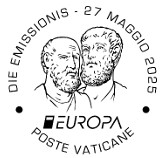Why were Roman necropolises, like those featured in the 2025 Vatican “Europa” stamps, typically located outside the city walls?
|
| To avoid disturbing sacred temples |
| Due to aesthetic preferences for rural settings |
| Because burial within city limits was forbidden by law |
| To protect graves from urban development |
Your answer was: Because burial within city limits was forbidden by law. |
| You are correct!! |
Answer: 
In ancient Rome, strict laws prohibited burials within the city walls for reasons of hygiene, religious purity, and public safety. As a result, necropolises—literally “cities of the dead”—were established along the major roads leading out of the city, such as the Via Triumphalis. This placement ensured that the tombs remained visible to travelers, preserving the memory of the deceased in the public eye. The Vatican’s 2025 “Europa” stamp series captures this poignant intersection of law, ritual, and remembrance. The artwork not only honors the archaeological richness of these burial sites but also reflects the Roman belief in the enduring presence of the dead among the living. The inclusion of named individuals, like Tiberius Natronius Venustus, and revered figures such as Peter and Paul, transforms these stamps into miniature monuments of memory and faith. |
